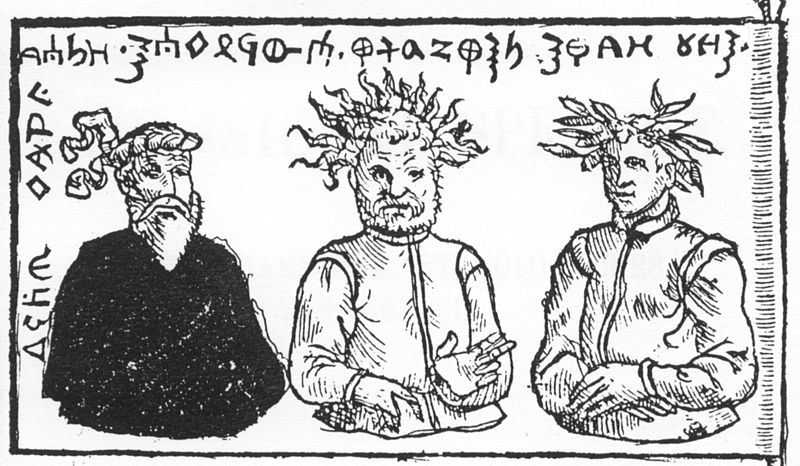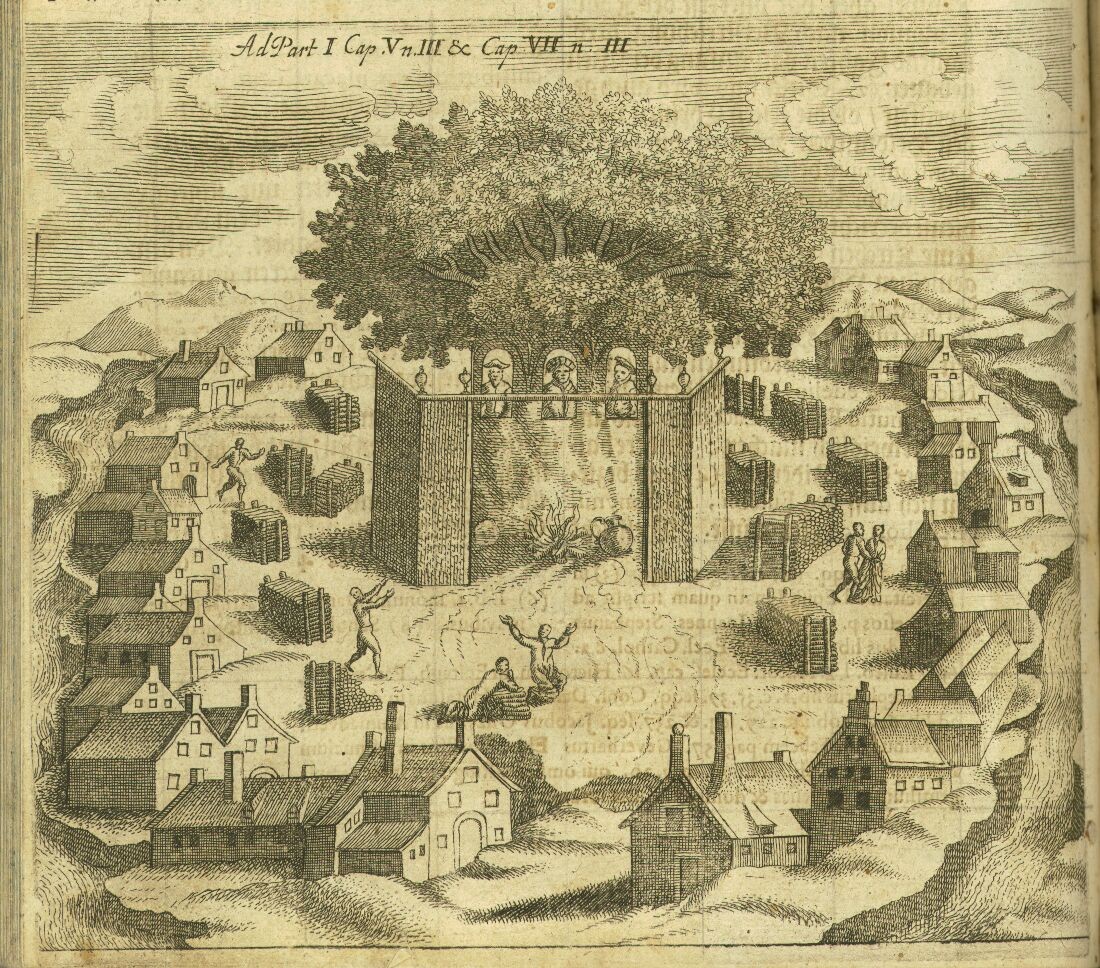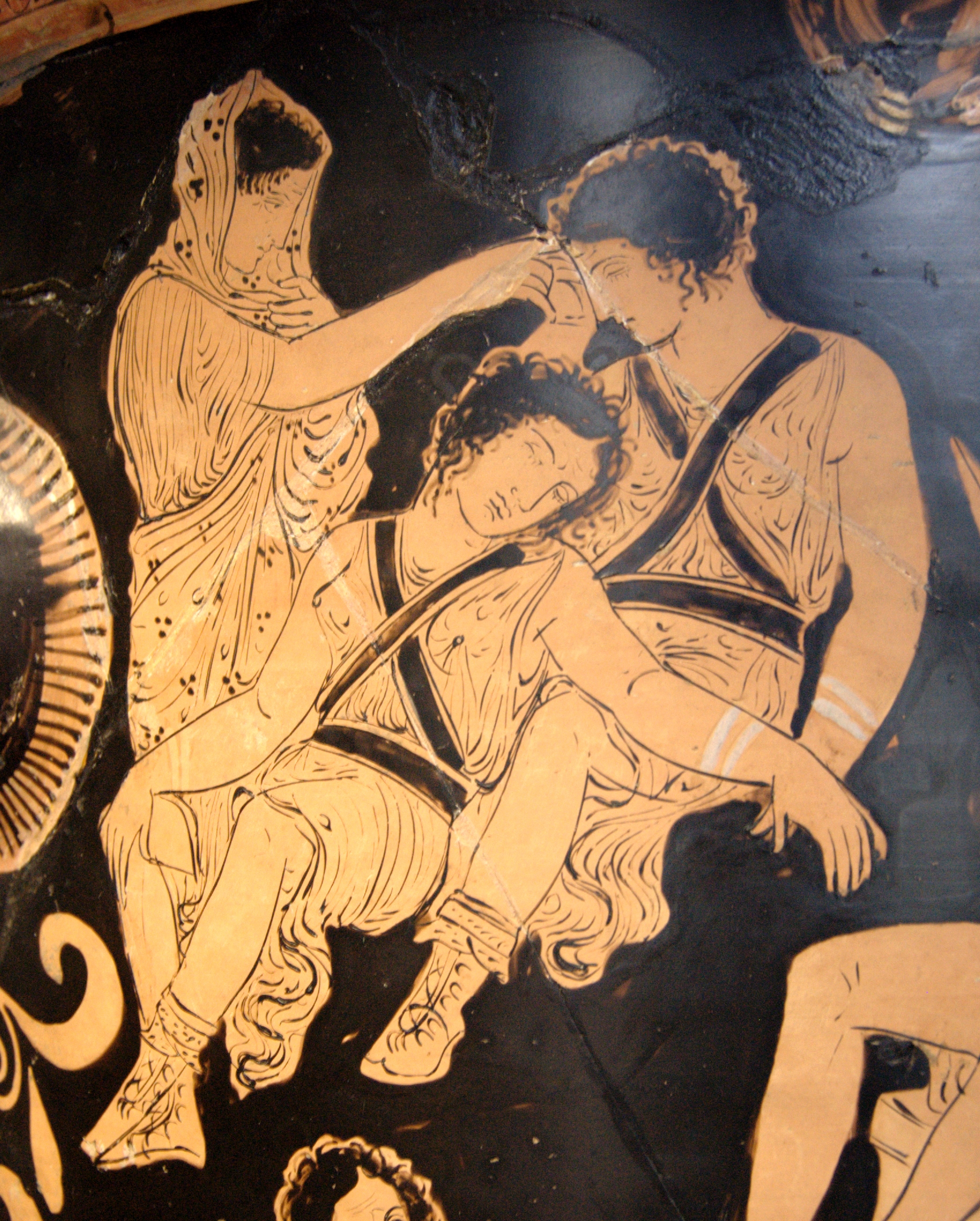|
Peckols
Peckols and Patollo (known under a multitude of different names) were gods in the pagan Prussian mythology who were worshiped by the Old Prussians. Most researchers believe that, despite varying names, Peckols and Patollo were probably the same god in charge of the underworld and the dead. It is usually described as an angry, evil spirit similar to the Lithuanian Velnias. ''Patollu'' was first mentioned in 1418 by Bishop of Warmia in a letter to the Pope. Chronicler Simon Grunau (1529) provided more vivid but dubious details about ''Patollo''. According to Grunau, ''Patollo'' was one of the three gods portrayed on the flag and coat of arms of King Widewuto and worshiped in the temple of Rickoyoto. He was portrayed as an old man with a white beard and a white headdress similar to a turban. He was a frightening and ruthless god of the dead who would haunt and taunt the living if they disobeyed their pagan priests or buried the dead without proper sacrifices to the gods. Many oth ... [...More Info...] [...Related Items...] OR: [Wikipedia] [Google] [Baidu] |
Prussian Gods
The Prussian mythology was a polytheistic religion of the Old Prussians, indigenous peoples of Prussia before the Prussian Crusade waged by the Teutonic Knights. It was closely related to other Baltic faiths, the Lithuanian and Latvian mythologies. Its myths and legends did not survive as Prussians became Germanized and their culture extinct in the early 18th century. Fragmentary information on gods and rituals can be found in various medieval chronicles, but most of them are unreliable. No sources document pagan religion before the forced Christianization in the 13th century. Most of what is known about Prussian religion is obtained from dubious 16th-century sources (''Sudovian Book'' and Simon Grunau). Historical background and sources The Teutonic Order, a crusading military order, began the Prussian Crusade in the 1220s. Their goal was to conquer and convert pagan Prussians to Christianity. The Knights built log and stone fortresses, which proved to be impregnable to the P ... [...More Info...] [...Related Items...] OR: [Wikipedia] [Google] [Baidu] |
Prussian Mythology
The Prussian mythology was a polytheistic religion of the Old Prussians, indigenous peoples of Prussia before the Prussian Crusade waged by the Teutonic Knights. It was closely related to other Baltic faiths, the Lithuanian and Latvian mythologies. Its myths and legends did not survive as Prussians became Germanized and their culture extinct in the early 18th century. Fragmentary information on gods and rituals can be found in various medieval chronicles, but most of them are unreliable. No sources document pagan religion before the forced Christianization in the 13th century. Most of what is known about Prussian religion is obtained from dubious 16th-century sources (''Sudovian Book'' and Simon Grunau). Historical background and sources The Teutonic Order, a crusading military order, began the Prussian Crusade in the 1220s. Their goal was to conquer and convert pagan Prussians to Christianity. The Knights built log and stone fortresses, which proved to be impregnable to the P ... [...More Info...] [...Related Items...] OR: [Wikipedia] [Google] [Baidu] |
Velnias
Veles,; Serbo-Croatian, Czech, Slovak, Russian, Slovenian: ''Veles''; Ruthenian and Old Church Slavonic: Велесъ; be, Вялес, translit=Vialies also known as Volos, is a major god of earth, waters, livestock, and the underworld in Slavic paganism. His mythology and powers are similar, though not identical, to deities such as Loki and Hermes. According to reconstruction by some researchers, he is the opponent of the supreme thunder god Perun. As such he probably has been imagined as a dragon, which in the belief of the pagan Slavs is a chimeric being, a serpent that devours livestock. His tree is the willow much like Perun's tree is the oak. No direct accounts survive, but reconstructionists speculate that he may directly continue aspects of the Proto-Indo-European pantheon. Sources Veles is one of few Slavic gods for which evidence of offerings can be found in all Slavic nations. The ''Primary Chronicle'', a historical record of the early Kievan Rus, is the earl ... [...More Info...] [...Related Items...] OR: [Wikipedia] [Google] [Baidu] |
Widewuto
Widewuto (also ''Viduutus'', ''Vidvutus'', ''Witowudi'', ''Waidewut'', ''Vaidevutis'') was a legendary king of the pagan Prussians who ruled along with his elder brother, the high priest (''Kriwe-Kriwajto'') Bruteno in the 6th century AD. They are known from writings of 16th-century chroniclers , Simon Grunau, and Lucas David. Though the legend lacks historical credibility, it became popular with medieval historians. It is unclear whether the legend was authentically Prussian (i.e. recorded from Prussian mythology) or was created by Grunau (possibly inspired by Biblical Moses and Aaron), though Lithuanian researchers tend to support its authenticity. Names Widewuto's name is found in literature in different forms: Veijdenutus, Vydevutis, Vidowuto, Viduutus, Waidewut, Wejdewut, Wenedut, Widewuto, Widewutte, Widiwutus, Wydowudo, Wydowudus, Widowuto, Wydowuto, Widowutus, Witoud, Witoudo, Witouito, Witowudus, Witowuto, Wotowudo, Vaidevutis (modern Lithuanian emendation). As for his bro ... [...More Info...] [...Related Items...] OR: [Wikipedia] [Google] [Baidu] |
Sudovian Book
The so-called ''Sudovian Book'' (german: Sudauer Büchlein, lt, Sūduvių knygelė) was an anonymous work about the customs, religion, and daily life of the Old Prussians from Sambia. The manuscript was written in German in the 16th century. The original did not survive and the book is known from later copies, transcriptions and publications. Modern scholars disagree on the origin and value of the book. Despite doubts about its reliability, the book became popular and was frequently quoted in other history books. Much of the Prussian mythology is reconstructed based on this work or its derivatives. It is known from Peter von Dusburg that 1,600 and 1,500 Sudovians were relocated to Sambia at the end of the 13th century. Their descendants still lived in the so-called Sudovian Corner and were known as determined believers in their pagan gods. Therefore, Norbertas Vėlius suggested that the work dealt not with Prussian, but with Sudovian gods and traditions. Authorship According to ... [...More Info...] [...Related Items...] OR: [Wikipedia] [Google] [Baidu] |
Flag Of Widewuto
A flag is a piece of fabric (most often rectangular or quadrilateral) with a distinctive design and colours. It is used as a symbol, a signalling device, or for decoration. The term ''flag'' is also used to refer to the graphic design employed, and flags have evolved into a general tool for rudimentary signalling and identification, especially in environments where communication is challenging (such as the maritime environment, where semaphore is used). Many flags fall into groups of similar designs called flag families. The study of flags is known as "vexillology" from the Latin , meaning "flag" or "banner". National flags are patriotic symbols with widely varied interpretations that often include strong military associations because of their original and ongoing use for that purpose. Flags are also used in messaging, advertising, or for decorative purposes. Some military units are called "flags" after their use of flags. A ''flag'' (Arabic: ) is equivalent to a brigad ... [...More Info...] [...Related Items...] OR: [Wikipedia] [Google] [Baidu] |
Erinyes
The Erinyes ( ; sing. Erinys ; grc, Ἐρινύες, pl. of ), also known as the Furies, and the Eumenides, were female chthonic deities of vengeance in ancient Greek religion and mythology. A formulaic oath in the ''Iliad'' invokes them as "the Erinyes, that under earth take vengeance on men, whosoever hath sworn a false oath". Walter Burkert suggests that they are "an embodiment of the act of self-cursing contained in the oath". They correspond to the Dirae in Roman mythology. The Roman writer Maurus Servius Honoratus wrote (ca. 400 AD) that they are called "Eumenides" in hell, "Furiae" on Earth, and "Dirae" in heaven. Erinyes are akin to some other Greek deities, called Poenai. According to Hesiod's ''Theogony'', when the Titan Cronus castrated his father, Uranus, and threw his genitalia into the sea, the Erinyes (along with the Giants and the Meliae) emerged from the drops of blood which fell on the Earth ( Gaia), while Aphrodite was born from the crests of sea ... [...More Info...] [...Related Items...] OR: [Wikipedia] [Google] [Baidu] |
Lithuanian Gods
Lithuanian may refer to: * Lithuanians * Lithuanian language * The country of Lithuania * Grand Duchy of Lithuania * Culture of Lithuania * Lithuanian cuisine * Lithuanian Jews as often called "Lithuanians" (''Lita'im'' or ''Litvaks'') by other Jews, sometimes used to mean Mitnagdim See also * List of Lithuanians This is a list of Lithuanians, both people of Lithuanian descent and people with the birthplace or citizenship of Lithuania. In a case when a person was born in the territory of former Grand Duchy of Lithuania and not in the territory of modern ... {{disambig Language and nationality disambiguation pages ... [...More Info...] [...Related Items...] OR: [Wikipedia] [Google] [Baidu] |
Death Gods
Death is the irreversible cessation of all biological functions that sustain an organism. For organisms with a brain, death can also be defined as the irreversible cessation of functioning of the whole brain, including brainstem, and brain death is sometimes used as a legal definition of death. The remains of a former organism normally begin to decompose shortly after death. Death is an inevitable process that eventually occurs in almost all organisms. Death is generally applied to whole organisms; the similar process seen in individual components of an organism, such as cells or tissues, is necrosis. Something that is not considered an organism, such as a virus, can be physically destroyed but is not said to die. As of the early 21st century, over 150,000 humans die each day, with ageing being by far the most common cause of death. Many cultures and religions have the idea of an afterlife, and also may hold the idea of judgement of good and bad deeds in one's life (heaven, ... [...More Info...] [...Related Items...] OR: [Wikipedia] [Google] [Baidu] |
Matthäus Prätorius
Matthäus Prätorius (c.1635–c.1704) was a Protestant pastor, later a Roman Catholic priest, a historian and ethnographer. Prätorius is thought to have been born in Memel (Klaipėda). He probably grew up speaking both German and Lithuanian, which helped him when preaching to the ethnic Lithuanians in Ducal Prussia. His work about Prussia and its culture, ''Deliciae Prussicae, oder Preussische Schaubühne'', resembles the work of Christoph Hartknoch, with whom he collaborated. Prätorius' work provides much more ethnographic information regarding local Lithuanians and Old Prussians. It was only published partially, in 1725 (in ''Erleutertes Preußen''), 1731 (in ''Acta Borussica'') and 1871. A complete edition, in seven volumes, with original German text and Lithuanian translation, is under preparation in Lithuania. In 1701, having converted from Protestantism to Roman Catholicism, he appealed against an ongoing case of witch-hunt. He died in Wejherowo (Weyherststadt). ... [...More Info...] [...Related Items...] OR: [Wikipedia] [Google] [Baidu] |
Christoph Hartknoch
Christoph Hartknoch (1644–1687) was a Prussian historian and educator. Biography Hartknoch was born in Jablonken (Jabłonka) near Ortelsburg (Szczytno) in the Duchy of Prussia. In 1650 the family moved to Passenheim (Pasym) and there witnessed the brutality and horrors of the Tatar attacks, fighting for the Kingdom of Poland, in southern Prussia. His life was saved by his teacher, who shoved him out the window. Numerous villages in the region were destroyed, but Hartknoch made it to the ducal capital of Königsberg. In Königsberg Hartknoch started studying theology at a Protestant institute. Soon after his parents died and he had to take on jobs. He became a private teacher in Kaunas and then a rector in the Protestant school in Vilnius. He soon returned to Königsberg where books and records interested him in history. In 1679 Hartknoch published a book about Prussian history, ''Old and New Prussia'', first in Latin and then in German, as well as a history of the churc ... [...More Info...] [...Related Items...] OR: [Wikipedia] [Google] [Baidu] |


.jpg)


